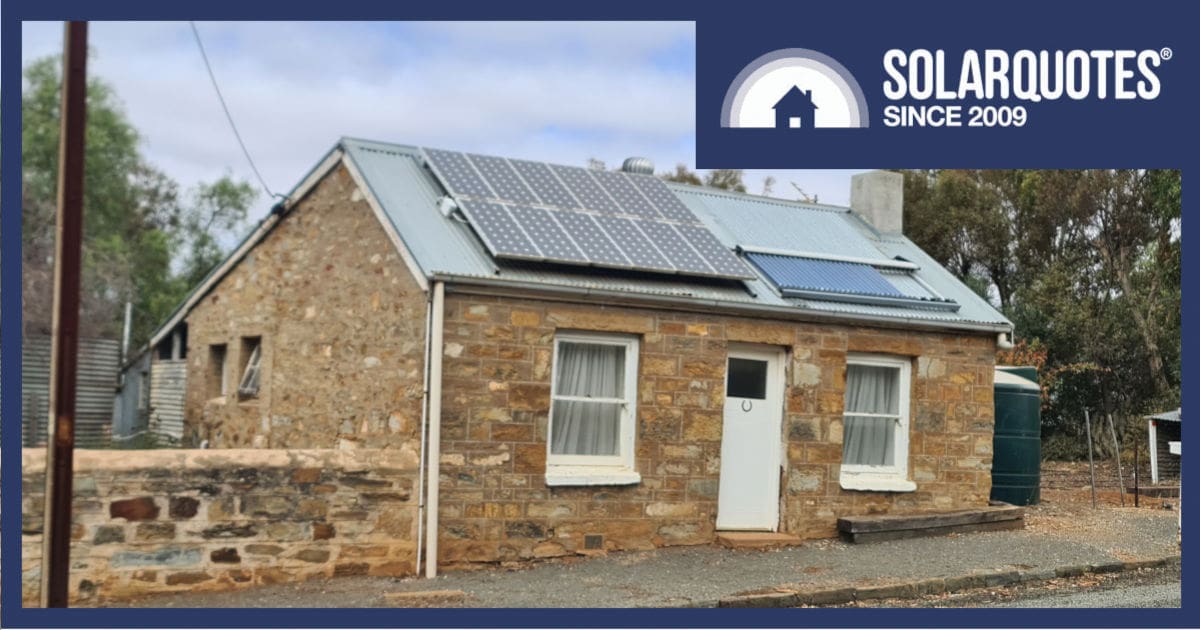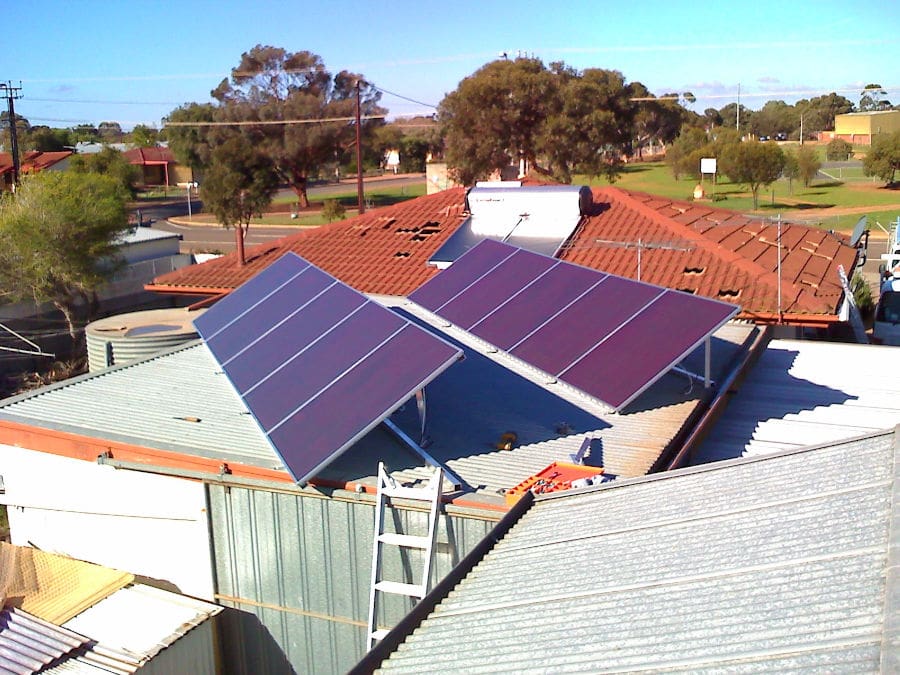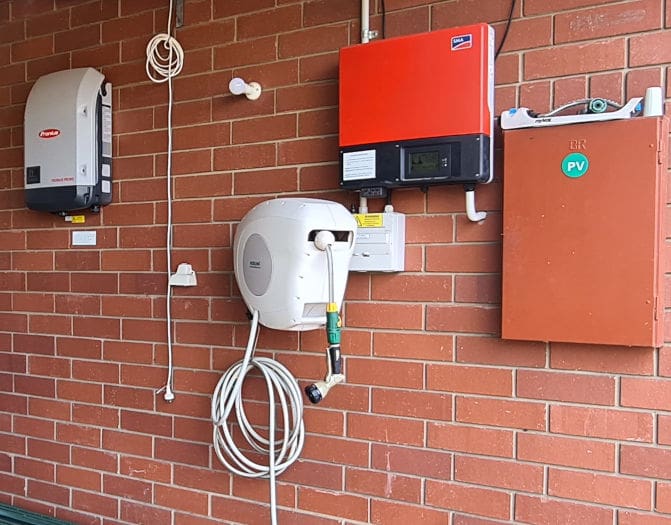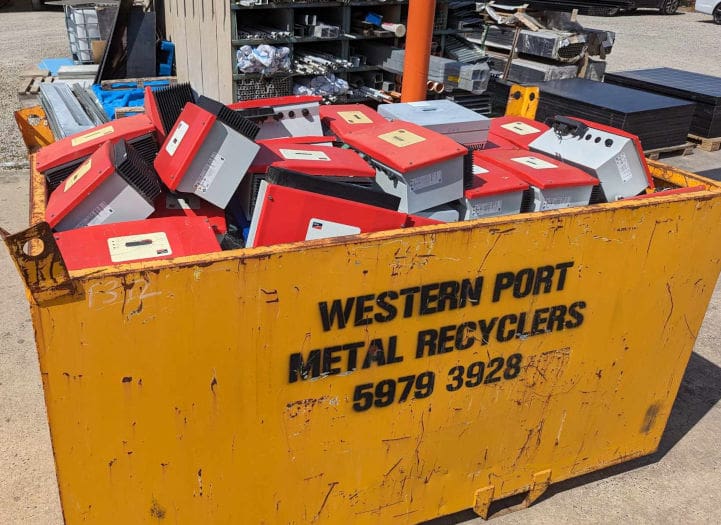
Like the rest of Burra, this solar system should be heritage listed.
Are you an early adopter of solar power? Are you wondering how to install a new solar system alongside your existing one? Or if you need to replace it entirely? And what about the solar rebate if you’ve already received it? Plus, how does the Premium Feed-in Tariff (FiT) factor into your decision?
In this episode, we’ll focus on older solar systems, generally those with small capacity and that are out of warranty, if you are looking to upgrade a more modern system check out Part 1 here. Or for middle aged solar installed in the twenty-teens, check out part 2.
Vintage Solar
If you’re an early adopter who bought one kilowatt for $12,000 retail, it’s likely paid off by now, especially if you enjoyed premium feed-in tariffs.
Though reinforcing poor customer behaviour, when I was installing them we told people; at 50c/kWh you could export all day, then “buy it back for less than half price”. Few imagined power prices would double inside a decade.
Happily, your money will buy ten times more solar capacity today. Despite inflation, solar system prices have fallen like a stone. So these days you don’t have to be precious about facing them due north, just fill the roof with solar panels.
I’m sentimental, but if yours is a quality system, say 6 Sharp panels with a Sunny Boy inverter, I’d keep it going while it still works.
However there’s reasons vintage solar should retire.
- They occupy the best roof space, making additional panels difficult.
- If it’s no-name panels with a Solar River, CMS, Sunny Roo or JFY inverter; then it’s junk anyway.
- Roughly speaking, STC credits (the rebate) pays for new panels; hence, existing panels are largely worthless.
- Moving old solar is usually futile. Pre 2013 panels aren’t compliant now
- Framing hardware will likely be seized & impossible to reuse
- Once wiring is brought up to current standards, you’re better off with a whole new system.

May 2008 and we were fitting 1kW of thin film Mitsubishi solar facing perfectly North.
Sadly Good Inverters Will Be Binned
It’d be nice to leave your old solar alone to do whatever good it can, adding more beside it in parallel. However, your old inverter may well be obsolete.
Networks are soaked with cheap midday energy now and the network companies are struggling to keep everything under control. New solar needs DNSP permission to connect a new inverter and that inverter must comply with the latest standards.
Fronius Proven Future Proof
When SAPN released the world leading flexible exports program, many existing inverters were rendered obsolete overnight, even 6 month old Enphase ones were junk at that point.1
However, with a firmware update, every Fronius SnapInverter sold for the last nine years is already good to go. Adding a second Fronius inverter makes solar expansions easy. 2
Rules Lag In NSW, Queensland and Western Australia
Should your DNSP only require a fixed export limit, you may be able to retain a legacy system. For example :
- If you have a 4kW system on the wall, adding a new 6kW inverter will conveniently fill the total allowable capacity of 10kW per phase.
- Meeting the rules just means having a consumption meter and configuring an export limit of 1kW on the new 6kW unit.
- The old unit can put out whatever it likes, the balance of the 5 allowable kilowatts will come from the new machine.
This option isn’t available in South Australia or Victoria, where equipment must be dynamic-export capable. In Queensland, flexible connections are optional, but the whole industry will soon follow.

Fronius Snap inverter in grey, SMA Sunny Boy TL5000 in red. Sadly the super durable red box can’t be made dynamic export compatible.
Old Panels Are (Almost) Worthless
If your old inverter fails, retaining a working array and adding more solar on a new inverter makes ethical sense. However inverter warranty may be rendered void if you connect old solar and there are good reasons for this. I have seen first hand where an earth leakage fault will cause a catastrophic failure in a new inverter. It may be the reason your first inverter died but can go undetected in dry conditions.
STC incentive rules will perversely mandate you remove old panels before installing new ones. STCs are only paid on complete new systems, with panels on the CEC approved product list. As older panels fall off the list, they technically can’t be used.
The CER may demand a statutory declaration that old panels remaining on the roof aren’t used on the new inverter. I couldn’t possibly recommend circumventing this technicality. If your electrician leaves them safely disconnected, you certainly shouldn’t plug them into the spare channel on the inverter. No siree, that would be a terrible crime… like binning working inverters.

Most of these SMA Sunny Boy units are 1.1 or 1.7kW, and most were working when decommissioned. Half of these had to be unloaded because the bin truck couldn’t lift such a heavy load. image credit: Karl Jensen
Old Microinverters Might Be Economical
Provided there aren’t DNSP inverter connection rules to breach, the AC wiring in a microinverter system is simple to rearrange. If you want to move an array, the framing hardware might still need to be renewed, but the expense of DC wiring and conduit would be avoided. Keeping solar out of the e-waste stream is always a good thing.
Standards Have Moved On
Many inverters predate AS4777 : 2015 or 2020, which will soon be updated again to include V2G supplies from vehicles. Hooray!
AS5033 (solar arrays) has changed significantly since 2014. Happily, the latest version has largely removed the requirement for dangerous, fire-prone, Roof Top DC Isolators. They were always a bad idea, so going back to the future is well worth the price of updating vintage solar; it’s a great step in safety and reliability to get RTI’s removed.
Along with emergency backstop and dynamic control standards from the networks, we have really seen solar transformed in the last 15 years.
Bigger Is Brighter
It pains me to say, some of my careful craftsmanship installing solar over the last 15 years has been scrapped already.
Where 1kW would run your fridge, 10kW is rapidly becoming the average system size. While solar has unusually long warranties, that doesn’t change the economics. Capacity has exploded as prices have plummeted.
It means rooftop solar is now the biggest generator in the nation. This is good news, which sadly, doesn’t sell newspapers or create clicks like a headline reading Sun Tax!
If you’re in Victoria, now’s the time to act. The end of the year rush is coming, and apathetic owners might face a double whammy: the expiry of premium tariffs and a 7% reduction in STC incentives. Planning ahead could save you both money and stress in the new year.
If you’re anywhere else, now’s the time to act. Prices have never been better and the sunshine on your roof is going to waste otherwise.

 RSS - Posts
RSS - Posts



The SA PFiT is a good incentive (for me) to hang onto our very early adopted solar.
Very surprised to see the Retailer FiT didn’t change from next July.
However I know in July 2028 I will be taking it all off as well as the current roof and slapping the biggest system I can fit on our North facing roof.
Assuming I am still above ground.
We have the bizarre situation where people take solar panels off rooves (or roofs if you have one of those sort of dictionaries) and consider them worthless, at the same time that growing numbers of people want solar power on caravans, RVs, and off grid shacks.
Ebay and its ilk are marketplaces rife with “chinese watts” ratings on near useless solar panels for caravans etc at silly prices.
I haven’t yet seen an enterprise that sells used solar panels for off grid use, but the market is ripe. In the meantime, gumtree can be a good source for bargains, as well as a good source of humor for some ludicrously overpriced upgrade surpluses.
I reckon no-one should ever buy new solar panels for off grid use (unless you have a shack with land area the size of the shack footprint, in which case efficiency is the fundamental factor.
Hi Koj,
I knew of at least one solar company that just left used panels out the front in a pile, they promptly disappeared.
Biggest issue with caravan solar is that even an old 1600mm x 800mm is often too big for a roof full of skylights, air cons, aerials and other junk. Plus you need a good quality solar regulator to deal with a panel that produces 45 volts open circuit.
Caravans roofs are full of junk, but houses can also have the same.
Vent pipes, skylights and whirlybirds, chimneys can all clutter up a roof space.
I’ve been slowly removing them from my roof so that we have less change of leaks, but also more space for panels.
Hi Dale,
If only there were more people like you the world would be a better place. 😉
https://www.solarquotes.com.au/blog/solar-roof-builders/
https://www.solarquotes.com.au/blog/getting-solar-right-building/
Additionally, it’s crucial to continue raising awareness about the long-term economic and environmental benefits of solar energy. Education and incentives can play significant roles in encouraging more people to make the switch.
I am considering putting an ‘off grid’ system on my rooftop, with batteries, to run most of my household load. The current 3.7KWh 2010 solar system has a caveat in the contract that says that if I alter the solar system in any way, the contract will be void. We pay about $0.30/KWh consumed, and the feedin tariff is $0.50/KWh. Basically we have no power bill annually since it was installed. But I am wondering now whether putting a 2nd solar system on the property could be construed as ‘altering in any way’ ? I fear to consult solar installer companies as I want to get advice that is based on “truth, not Sales”.